Clothing
What do these photos tell you about the kind of clothes they wore?
Elitch Gardens Theater
The people in this photo are gathered outside the Elitch Gardens theater in Denver. They are dressed for the theater.
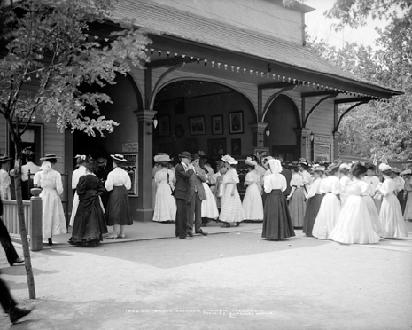
Photo: Denver Public Library, Western History Collection
More About This Topic
This photo shows the women's dresses and men's suits that were in style in the early 1900s. Long, white dresses with sleeves puffed at the shoulder were popular for summer wear. Women wore wide-brimmed hats for dress-up occasions like attending the theater. Men usually wore plain dark suits and felt hats.
Their Own Words
"Ladies those days wore big hats held on with a long hairpin. It was pointed on the end to penetrate any kind of cloth and some of the softer heads. I recall my mother used to feel that thing very carefully through her hair, until it came out the other side."
Source: Forrest Coulter, “65 Years of memories,” p. 13. Denver Public Library Manuscript Collection.
Woman With Bicycle
The woman in this photo is wearing a sports outfit. The photo was taken beside the lake in Denver's City Park about the year 1900.
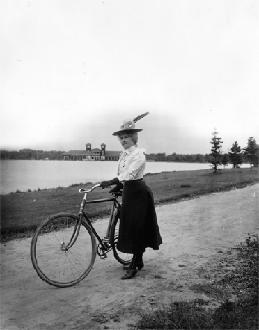
Photo: Denver Public Library, Western History Collection
More About This Topic
The bicycle and other recreational fads of the 1890s had an impact on women's clothing. They could hardly ride a bicycle in the long skirts and dresses fashionable at that time. The proper sports clothes included shorter skirts, riding gloves, and a sporty hat.
Their Own Words
"I liked to look at ladies' high button shoes and at their long, buttoned gloves. They used to have full-sized buttoners for the shoes called a button hook, and tiny ones for the gloves. And gloves were supposed to go on easier if powder was shaken into them from a small, dainty wooden container somewhat in the shape of a bottle."
Source: Quantrille D. McClung, Memoirs of My Childhood and Youth in North Denver (Denver: Colorado Genealogical Society, 1979).
William Jackson Palmer
This is a photo of William Jackson Palmer, who founded the city of Colorado Springs. He posed for this photo wearing a white shirt and a tie, a long sack coat, and trousers that fit into his boots.
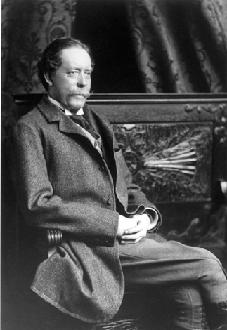
Photo: Denver Public Library, Western History Collection
More About This Topic
Most men of the late 1800s owned a sack coat for informal, everyday wear. Sack coats were not tightly fitted. The cloth hangs, like a sack, in a relatively straight line from the shoulders to the hem. The long coat that Palmer wore in this photo was especially popular in the 1870s and 1880s.
Their Own Words
"Ladies--Three to twelve petticoats were usual and at least three had to be taffeta to create a swish.
Men--The man who escorted the Gibson Girl through City Park on a Sunday afternoon wore a Prince Albert coat with a silk hat and a cane. . .when he went to work he togged out in a derby and cutaway coat. . .in summer he changed for a straw hat with a black cord anchoring it to the lapel of his short seymore coat."
Source: Reflections of Frances Melrose, Rocky Mountain News, September 15, 1946.
Two Young Boys
These boys are wearing long-sleeved, winter shirts, short pants called knee breeches, and long stockings. The boy next to the tree is wearing a tie with a big polka-dot bow.
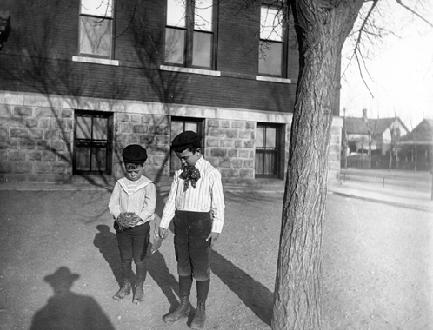
Photo: Denver Public Library, Western History Collection
More About This Topic
The boys in this photo probably were wearing their best clothes. In the late 1800s, young boys usually wore short pants when they dressed up.
Workers In a Blacksmith Shop
The men in this blacksmith shop in Denver wore work clothes and aprons that protected them for the kind of work that they did. For example, blacksmiths often worked with hot metals for making such things as horseshoes.
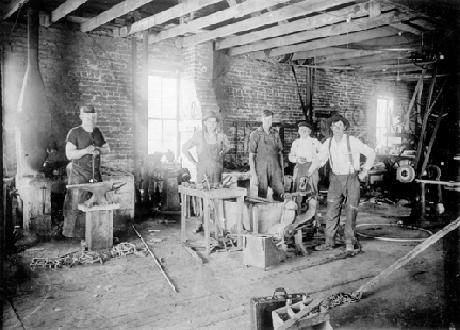
Photo: Denver Public Library, Western History Collection
More About This Topic
The standard work outfit for men included pants and a shirt or overalls. Many men wore suspenders rather than belts to hold up their pants. It was common for men to wear hats when they worked.
Their Own Words
“There was a blacksmith shop. . . . I used to love to go past that as I was going downtown and watch the blacksmiths shoeing horses and making horseshoes. Hearing the pounding of the hammers and anvils and seeing the red-hot metal that they shaped.”
Source: Franklin Folsom quoted in Maria M. Rogers, ed., In Other Words: Oral Histories of the Colorado Frontier (Golden, CO: Fulcrum Publishing, 1996): 55.
An Immigrant Family
This is an immigrant family in Denver. They are wearing everyday clothes. The photo was taken about the year 1900 in the family's apartment.
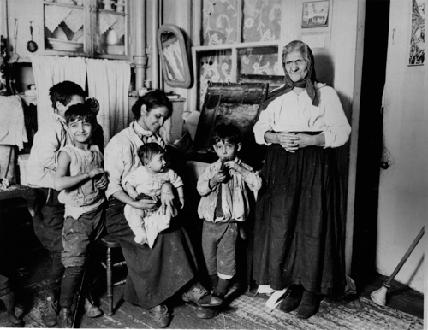
Photo: Colorado Historical Society
More About This Topic
Women wore skirts and blouses at home. Boys usually wore shirts and short pants. Immigrant women often wore kerchiefs on their head like the woman standing in this photo.
Their Own Words
"About the time we built our Bell Street house (1893) there was a great influx of Italians into Denver. They settled in North Denver and began truck gardening in the Platte River bottoms. . . .These women were always soberly dressed in black calico, shapeless dresses, black aprons with little black shawls around the shoulders or over the head."
Source: Quantrille D. McClung, Memoirs of My Childhood and Youth in North Denver (Denver: Colorado Genealogical Society, 1979): 32.

